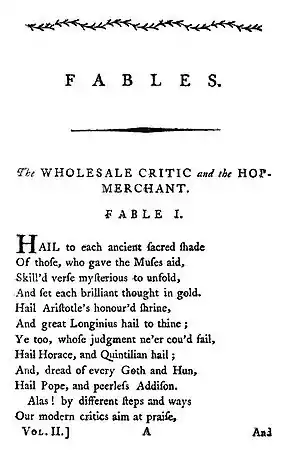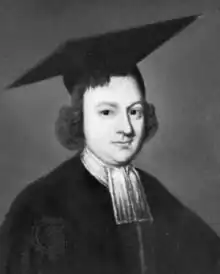Smart's Fables
The Fables by Christopher Smart were written between 1750 and 1767 and partly published in the periodicals The Midwife; or The Old Woman's Magazine, The Gentleman's Magazine, The Literary Magazine, etc. The order in this collection of the fables was made by Smart himself and Christopher Hunter, Smart's biographer and nephew, after him, as it was printed posthumously in 1791 edition.

Contents
| Fable I. | The Wholesale Critic and Hop-Merchant 17??, publ. posth. 1791 |
| Fable II. | The English Bull Dog, Dutch Mastiff, and Quail 1755, publ. 1758 |
| Fable III. | Fashion and Night 1751, publ. 1752 |
| Fable IV. | Where's the Poker? 1752 |
| Fable V. | The Tea Pot and Scrubbing Brush 1753 |
| Fable VI. | The Duellist[s] 1754 |
| Fable VII. | The Country Squire and the Mandrake 1755 |
| Fable VIII. | The Brocaded Gown and Linen Rag 1754 |
| Fable IX. | Madam and the Magpie 1767 |
| Fable X. | The Blockhead and Beehive 1754 |
| Fable XI. | The Citizen and the Red Lion of Brenton 1754 |
| Fable XII. | The Herald and Husband-Man 17??, publ. posth. 1791 |
| Fable XIII. | A Story of a Cock and a Bull 1756 |
| Fable XIV. | The Snake, the Goose, and Nightingale 1754 |
| Fable XV. | Mrs. Abigail and the Dumb Waiter 1755 |
| Fable XVI. | The Bag-Wig and the Tobacco-Pipe 1750 |
| Fable XVII. | Care and Generosity 1751 |
| Fable XVIII. | The Pig 1752 |
Quotations
Among the shorter poems, the fables were the pieces most highly prized by Smart's contemporaries, and they still wear well, showing a lightness of touch and acuteness of social observation that made eighteenth-century critics put him in the same league as John Gay. Charles Burney in the Monthly Review (January 1792) rated him "the most agreeable metrical Fabulist in our language" after Gay, finding that although his versification was less polished and "his apologues in general perhaps less correct" than those of Gay and Edward Moore, nevertheless "in originality, in wit, in humour, the preference seems due to Smart."
